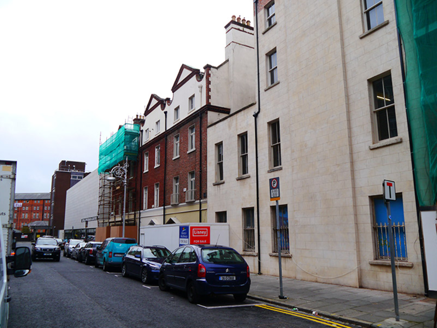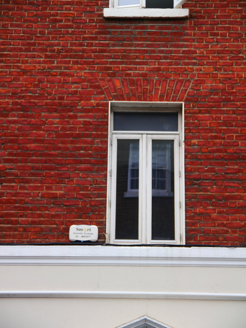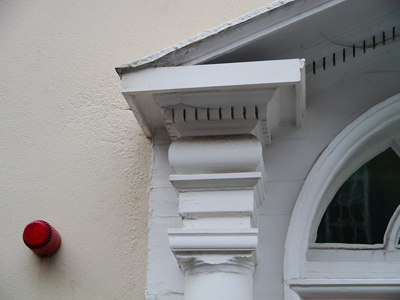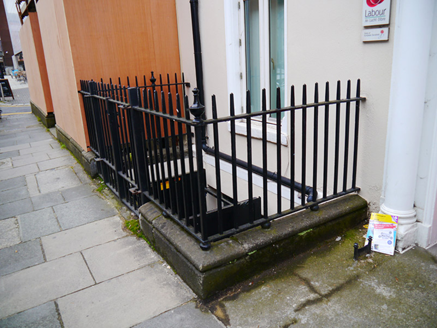Survey Data
Reg No
50920311
Rating
Regional
Categories of Special Interest
Architectural, Artistic, Historical
Original Use
House
Date
1765 - 1775
Coordinates
316324, 233291
Date Recorded
21/10/2015
Date Updated
--/--/--
Description
Terraced two-bay three-storey townhouse with attic and basement, built c. 1770, as part of a terrace comprising Nos. 16-18 (50920310-2) and remodelled in 1906. Currently vacant. M-profile slate roof, hipped to rear, with rendered chimneystack having red brick dressings and lipped red clay pots to southern party wall. Roof concealed behind red brick dentilled pediment with rendered tympanum flanked by U-shaped parapets with red brick coping, flanked by granite coping stones. Concealed gutters with flanking cast-iron hoppers and down pipes breaking through. Rendered walling to third and ground floors with rendered platband stringcourses and red brick pier. Red brick walling laid in Flemish bond to first and attic floors, surmounted by projecting red brick cornice over cogged stringcourse. Square-headed window openings with projecting masonry sills. Those to first and second floors with patent reveals and brick voussoirs, those to ground floor with bolted moulded reveals. uPVC casement windows throughout. Narrow tripartite casement window to north of entrance door. Round-headed entrance door to northern bay set in doorcase comprising Doric columns on plinth stops rising to open pediment. Replacement fanlight over nine-panelled timber door with brass furniture opening on to entrance platform (shared with No. 18 (50920310) to north) with cast-iron bootscraper, shallow ramp to street level. Cast-iron railings on granite plinth enclosing basement well to south, with square-headed uPVC entrance door at basement level accessed from street level by recent lifting platform. Street fronted on east side of Ely Place Upper.
Appraisal
Dublin Civic Trust's 'Survey of Gable-Fronted Houses and Other Early Buildings of Dublin' (2012) states ‘Laid out c. 1770 and named after Viscount Loftus of Ely, this group of houses on Ely Place was built by Nicholas Trench and remain the earliest buildings on the street. Deceptively Edwardian in appearance, the three houses date to the laying out of the street in the late eighteenth-century, however all were heavily remodelled in the opening years of the twentieth century under the supervision of the noted architect Thomas Manly Deane, who lived and worked in the adjacent No. 15 from 1897 to 1908 (since demolished). The houses 'plot divisions do not correspond with the larger mansions depicted on Bernard Scalé’s 1770s map of Dublin, which may account for the unorthodox disposition of accommodation inside No. 16 and No. 17 due to subsequent alterations. The group was remodelled by Thos. Dockrell & Sons in 1906, where Deane added picturesque mansard roofs and Dutch gables in a curious reinterpretation of the early eighteenth-century ‘Dutch Billy’ while retaining their original red brick facades to the lower levels. The interior detailing of all houses is somewhat antiquated and unusual in layout for their time and may have been built with a specific function in mind. Based on this, and the idiosyncratic remodelling executed by Deane, it is possible the houses were originally gable-fronted, constituting the last gasp of the gabled tradition in Dublin in the late eighteenth-century.'















